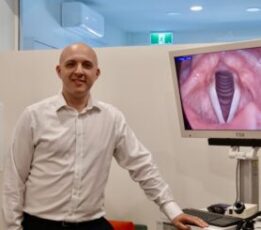Vocal Cord Dysfunction
Vocal Cord Dysfunction (VCD) is a condition wherebythe vocal folds within the larynx close involuntarily during breathing. This can be while breathing in, out or both.
It is also known as Paradoxical Vocal Fold Motion (PVFM), or Inducible Laryngeal Obstruction (ILO)

The pictures above show a closed compared to open vocal fold posture
The exact cause of VCD is frequently unknown however it may be influenced by: reflux, physical exercise, neurological changes, stress/emotional factors, talking, laughing and environmental triggers such as strong fumes, smoke or pollen. In VCD, the vocal cords (and sometimes the muscles above these on the larynx) react to these triggers and close off the airway or move in the wrong way as a response. This dysfunctional response of the larynx can usually be consciously controlled with specific training.
VCD can occur in conjunction with asthma or in isolation.
Symptoms:
Symptoms may include shortness of breath, noisy breathing/wheezing, coughing, hoarse voice and tightness in the throat or chest.
VCD can often co-occur orbe mistaken for asthma, as it can lead to breathing difficulties. One distinct difference between the two disorders is that with asthma, medications (such as Ventolin) can improve breathing, but with VCD alone, these medications will not be effective. Episodes of VCD can be sudden and may be severe. They may be triggered by exercise, environmental factors or stress. The onset of symptoms is mostly sudden and these can occur for very brief periods but sometimes last for several hours. VCD symptoms do not usually occur during sleep although you may sometimes wake up and have an episode.
Diagnosis:
VCD can bediagnosed by a team of specialists, including Ear, Nose & Throat Specialists, Respiratory Physicians and Speech Pathologists. Diagnosis can be difficult because symptoms vary between individuals and episodes are not always predictable. A number of tests may be used to diagnose VCD including stroboscopy/endoscopy, Dynamic CT scan, breathing tests such as lung function, spirometry and non-response to asthma medications.
Treatment
- Speech/vocal cord therapy–involves behavioral modifications including vocal cord re-training, postural changes and correctbreathing techniques to maximise the opening of the vocal folds and decrease the potential for constriction. Speech therapy also identifies triggers for VCD episodes along with strategies to prevent and manage these when they occur.
- Medical management–involves several approaches such as muscle relaxants, anti-reflux medications, sensory nerve modulating agents,and in some cases, Botox®injections into the vocal cords. Medical management may be delivered through a variety of professionals including respiratory physicians, GPs, ENT specialists and neurologists.
- Psychological support–strong emotions and stress may trigger VCD, therefore learning some management strategies froma mental health clinician may also be helpful
Outcomes
- When there is no co-existing asthma, a person is considered to be successfully managing VCD when they report to be consistently symptom free and able to breathe throughout usual activities or exercises without distress or needing to temporarily pause to ‘catch one’s breath’. Other tests can be performed to support these reports of improved breathing.
- In patients who arealso on asthma medications, many people with VCD are able to reduce their medications under medical supervisionwith specific vocal cord re-training. Outcomes are carefully evaluated using specific measures to delineate the VCD versus asthma contribution to breathing issues.







